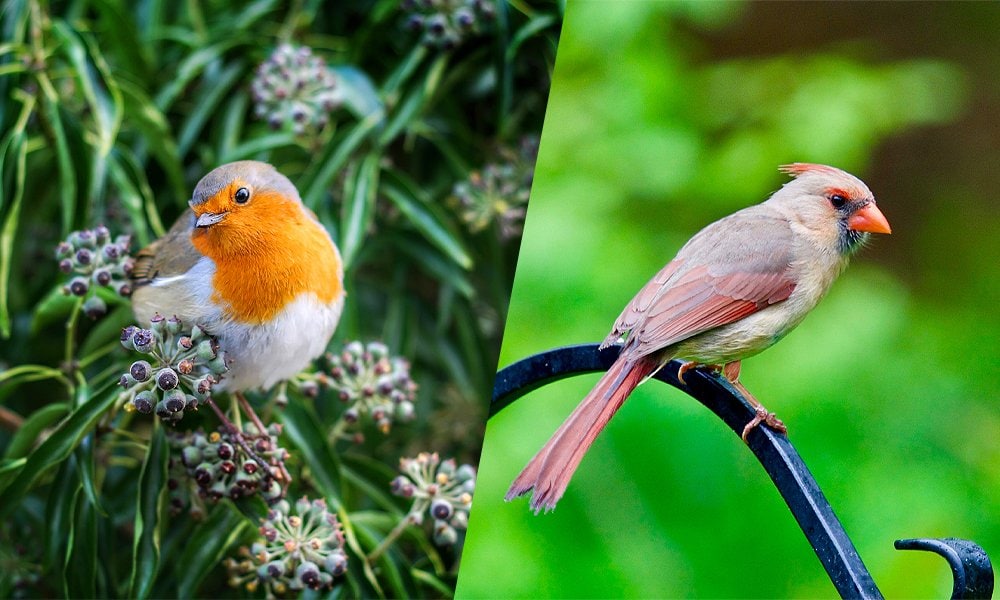Interesting Facts About: Robins Vs Cardinals
When the dawn chorus breaks, two feathered icons often take center stage: the American Robin and the Northern Cardinal. Both birds are beloved by nature enthusiasts and casual observers alike, each sporting striking colors and captivating songs that herald the arrival of spring. Yet, despite their shared habitat and seasonal timing, these avian champions embody contrasting personalities that spark curiosity among birdwatchers.
In this vibrant showdown of Robins vs Cardinals, we’ll dive into their distinctive traits, how they forage for food, defend their territories, and even express affection through song. Are you team Robin with its warm orange breast or do you lean towards the bold beauty of a Cardinal? Join us as we explore what makes these two species not just neighbors in our backyards but also fascinating foils in the great tapestry of nature’s design.
Differences Between Robins Vs Cardinals
| Feature | Robins | Cardinals |
| Size | Robins are birds of moderate size known for their plump bodies. | Cardinals generally appear a bit smaller in size, yet they have a sturdier look. |
| Color | The robin’s bright orange underbelly stands out strikingly against its gray back, enhanced by a charming white ring encircling its eye. | In sharp distinction, male cardinals display vibrant red feathers that allow them to be easily noticed in any environment. Female cardinals have a more understated brown coloration but still feature warm red highlights and a unique crest on their heads. |
| Beak | Robins have slender yellow beaks that are perfectly designed for extracting worms from loose earth. | Cardinals possess robust beaks in a vibrant orange-red hue, uniquely adapted for breaking open seeds. |
Their Unique Songs
The songs of robins and cardinals offer a delightful auditory tapestry that enhances the natural world around us. Robins croon a cheery, melodious tune reminiscent of spring’s arrival, often composed of clear, flute-like phrases that can evoke feelings of nostalgia. Their repertoire serves not just as communication but also as a celebration; each note seems to ripple through the air, beckoning listeners to relish in nature’s awakening.
In contrast, cardinals deliver a bold symphony that stands out vividly against their lush surroundings. Their calls range from bright whistling notes to sharp tweet-tweet sounds, creating an unmistakable presence in the backyard or woodland. This sonic vibrancy carries practical purpose; it stakes territory and attracts mates with its confidence and clarity.

Where Do They Live?
Robins and cardinals each carve out their unique territories across North America, showcasing striking contrasts in their habitat preferences. The American robin thrives in a diverse range of environments, from bustling urban areas to serene forests and open fields. Their adaptability allows them to nest even in suburban backyards, serenading residents with cheerful songs as they search for worms on the ground.
In contrast, the northern cardinal revels predominantly in dense thickets and shrubby areas. These vibrant birds favor regions with ample cover, think tangled vines or thick shrubs, in which they can roost safely and showcase their brilliant plumage. Interestingly, while robins often migrate further south for the winter, cardinals remain year-round residents in many areas, maintaining their lively presence even amidst a winter backdrop. This difference not only highlights their varied lifestyles but also reflects how habitat choices can shape behavior and interactions within our shared ecosystems.
What Do They Eat?
Robins and cardinals, while both beloved backyard birds, have distinct dining preferences that reflect their unique adaptations. Robins primarily feast on insects, worms, and fruits, showcasing their foraging prowess as they hunt for earthworms in your garden’s soft soil. Moreover, during the nesting season, they’ll often turn to caterpillars and other invertebrates to provide essential protein for their hungry chicks.
In contrast, cardinals are known for their seed-centric diet. They relish sunflower seeds and small berries, using their strong beaks to crack open tough shells with ease. What’s fascinating is the cardinal’s adaptability; while they are primarily granivorous (seed-eaters), they also incorporate insects into their meals during breeding season, just like robins, to ensure their young get a well-rounded diet.

Fun Facts Alert!
Robins and cardinals, both beloved backyard birds, showcase striking differences that make them fascinating to observe. While robins are known for their cheerful songs heralding spring and their distinctive orange-red breast, cardinals captivate with their vibrant red plumage and bold crest. Interestingly, the female cardinal is just as stunning as her male counterpart, often showing off warm brown tones accented by subtle hints of red, making them stand out in a different way compared to the more subtly colored females of the robin species.
Behaviorally, robins exhibit unique feeding habits; they hunt for worms by listening intently to the vibrations in the ground. In contrast, cardinals are seed enthusiasts, using their stout beaks to crack open seeds and nuts efficiently. This specialized diet not only influences where you might spot each bird but also highlights nature’s uncanny ability to adapt species for survival in various ecosystems, each thriving beautifully in its niche while captivating human admirers with their vibrant colors and distinct behaviors.
Making Their Nests
When it comes to nesting, robins and cardinals showcase strikingly different approaches that reflect their unique lifestyles. Robins typically prefer to build their nests in safer spots, often opting for tree branches or shrubs that provide some shelter from the elements and predators. Their nests are carefully constructed using mud, grass, and twigs, a blend that creates a sturdy foundation while still offering insulation for their vulnerable eggs. Interestingly, robins also exhibit remarkable adaptability; they can adjust the location of their nests based on changing environmental conditions or threats nearby.
In contrast, cardinals take a more closed-off approach to their nesting habits. Preferring dense thickets or vines for cover, these vibrant birds often choose locations where they can obscure their nests from plain sight. The materials used by cardinals, including twigs, leaves, and sometimes even bits of plastic, deliver not only durability but also camouflage against potential threats

Helping Them Thrive
When it comes to enhancing backyard habitats for robins and cardinals, understanding their specific needs can lead to a thriving environment. Robins are ground-foragers, favoring open spaces where they can hunt for worms and insects. To support them, create clear patches in your garden with native grasses or mulch that allows these birds easy access to the soil while providing natural camouflage from predators. A birdbath with shallow edges also encourages robins to visit: they love splashing around and are drawn to fresh water sources.
Conversely, cardinals prefer dense shrubbery and elevated perches for feeding on seeds and berries. Planting berry-producing bushes like serviceberry or holly not only offers food but also sustains nesting sites. Consider adding feeders filled with sunflower seeds, their favorite, that attract not just cardinals but other seed-loving species as well. By balancing these tailored approaches, you can create a lively ecosystem that nurtures both iconic birds while enjoying their distinctive songs and vibrant colors in your outdoor space.
Readmore: Explore Strongest Birds in the world that you never in your life.
Summary
While robins and cardinals both bring vibrant color and charm to our backyards, they each possess unique characteristics that set them apart. Robins are often celebrated for their melodic songs and early arrival in spring, symbolizing renewal and warmth. In contrast, the striking red plumage of cardinals adds a bold splash of color against winter’s backdrop, making them a favorite among birdwatchers year-round. Understanding these differences can deepen our appreciation for the diverse avian life around us.
FAQs
What do robins eat?
Robins mainly eat insects and earthworms, which is why they are often seen hunting in lawns and gardens. In spring and summer, they look for these protein-rich foods to feed themselves and their young. Common insects they eat include beetles, caterpillars, and grasshoppers, while they pull earthworms from the ground, especially after it rains. As the seasons change, so does their diet. In fall and winter, when insects are hard to find, robins eat fruits and berries. They like various fruits, including berries from holly, crabapple, and serviceberry trees.
What do robins symbolize?
Robins symbolize renewal and new beginnings, especially in cultures that link them to spring. Their bright red breasts and cheerful songs bring warmth and hope after winter. In folklore, robins represent transformation and the promise of better days, making them a strong symbol for those wanting change or healing. They also carry meanings of love and care. In some traditions, robins symbolize loved ones who have passed away, reminding us that our connections last even after death.
What do cardinals eat?
Cardinals primarily have a diet that consists of seeds, fruits, and insects. They are particularly fond of sunflower seeds, safflower seeds, and various berries such as elderberries and blackberries. In the wild, they often forage for food on the ground or in shrubs and trees, using their strong beaks to crack open tough seeds and nuts. During the breeding season, cardinals also consume more protein-rich foods like insects and caterpillars to support their growing chicks.
What do cardinals represent?
Cardinals are often seen as symbols of hope, renewal, and spiritual connection. In many cultures, their vibrant red color is associated with vitality and the life force, making them a powerful emblem of warmth and positivity. For many people, spotting a cardinal can evoke feelings of comfort or serve as a reminder of loved ones who have passed away, reinforcing their role as messengers from the spiritual realm. Cardinals also carry various meanings in different contexts. For instance, in Christianity, they can represent the blood of Christ due to their striking coloration. In Native American traditions, cardinals are sometimes viewed as protectors or guides that bring messages from ancestors.
- Explore Top 13 Animals That Are Sneaky (With Pictures) - October 16, 2024
- Interesting Top 13 Slow Animals In The World (With Pictures) - October 16, 2024
- Top 16 Interesting Animals That Are Independent (Images Included) - October 16, 2024







